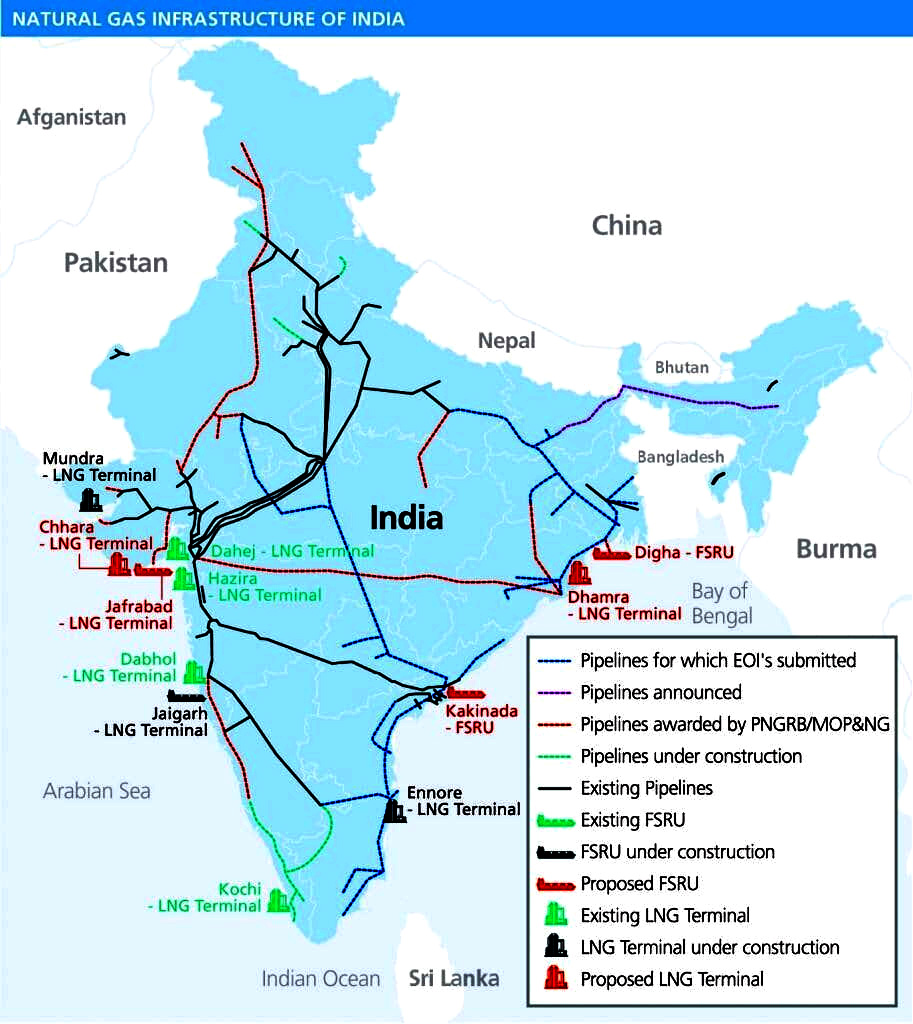The Big Picture : One Nation, One Gas Grid | 12 Jan 2021
Why in News?
- The Prime Minister of India has recently inaugurated the 450-km natural gas pipeline between Kochi in Kerala to Mangalore in Karnataka.
- The government has set the energy roadmap, envisaging more than double the share of cleaner natural gas in the consumption basket, diversifying sources of energy, connecting the nation with one gas pipeline grid and bringing affordable fuel to people and industry.
Key Points
- A gas-based economy is crucial for an Atmanirbhar Bharat and work is being done in the direction of 'One Nation, One Gas Grid'.
- The pipeline grid is expected to not only help improve clean energy access, but also aid in the development of city gas projects.
- The government is also considering the proposal of bringing natural gas under the ambit of Good and Services Tax.
One Nation, One Gas Grid
- The Indian Power system for planning and operational purposes is divided into five regional grids.
- One Nation, One Gas Grid refers to the integration of these regional grids thus establishing a National Grid for providing energy produced by natural gas to various stakeholders like the central government, the state governments, the public and the private sectors.
Objective and Need of One Nation & One Gas Grid
- Meeting the targets: The initiative of the Indian government will help meet its target of reaching 15% natural gas in its energy basket mix by 2030 which is currently at 6.2-6.5% whereas the global average is 23-24%.
- Connecting the nation: With one nation and one gas grid, the energy produced from natural gas will be supplied to the whole country via a single source.
- Improving regional imbalance: It will help in improving the regional imbalance of gas availability as currently the natural gas is only in limited pockets of the country.
- India as a gas based economy: One nation, one gas grid which will help emerge India as a gas based economy.
- It will not only lead to robust development in the economy but also encourage a clean environment.
- Cleaner environment: In times when conventionalsSources are depleting and mining is being extended to a greater depth and area, natural gas can prove to be a boon by preventing deforestation and desertification.
- Reduce import dependency: The import dependency of natural gas in India has reached to 53%. In order to reduce this high percentage, the government is taking measures to diversify the energy mix of India.
India’s Targets
- To increase the share of natural gas, the government has announced the expansion of the natural gas grid from the previous 17,500 kilometers to 34,500 kilometers. To which, 450 kms have already been added making it approx 18000.
- The next 16000 kms is expected to be achieved in the next 4-6 years.
- Primarily, as a grid, the north and west part of India were already connected via LNG terminal.
- In the last 4 years, efforts have also been made to connect eastern India with North via the Jagdishpur-Haldia-Bokaro-Dhamra Pipeline which is a PM Urja Ganga Project which is in its final stages and will also add around 3000 kms to the grid.
- The southern part of India is also being looked upon and is expected to add about 1500 kms to the grid.
Way Forward
- Encouraging investments: Investing in natural gas should be more encouraged. The share can be divided as : 20% for smaller manufacturing brands whereas for the government and bigger companies it should be 80%.
- It is important because investing in natural gas means investing in:
- Cleaner environment
- Better health for our people
- Creating more jobs and a better economy for our people.
- It is important because investing in natural gas means investing in:
- Educating about natural gas: One area where we all should work is in educating people about the natural gas economy because at present the lack of knowledge about natural gas based economy is widely persistent.
- Empowering the vehicles: Empowered vehicles are needed to reach the destination of One Nation, One Gas Grid. Vehicles such as GAIL, ONGC etc need to be strengthened and empowered to eradicate natural gas energy poverty.
- It is important to give more importance to companies like ONGC when it comes to upstream for gas and GAIL India when it comes to midstream production and gas distribution, and to companies like Oil India when it comes to oil distribution.
- We need more LNG terminals for more upstream production of gas.
- It is important to give more importance to companies like ONGC when it comes to upstream for gas and GAIL India when it comes to midstream production and gas distribution, and to companies like Oil India when it comes to oil distribution.
- Marketing and pricing reforms: To increase domestic exploration, investment and production of natural gas, Marketing and Pricing Reforms are the one step that the Government of India has taken in a couple of months.
- Natural gas democracy: Like no citizen of a country should be kept out of democracy, similarly no one should be left out of the benefits of natural gas, it should reach each and every household.
- Collaborative effort: It is not enough that only the central government takes initiatives in the direction, various state govts should also come on board or even a public sector is also as important when it comes to contributing their share in the notion of One Nation, One Gas Grid.
Conclusion
Tremendous efforts are on the way to achieve clean affordable and sustainable energy but going forward there will be infrastructure related and many other possible challenges that must be tackled in order to end energy poverty in the times to come, ensuring energy security for the citizens as well.

